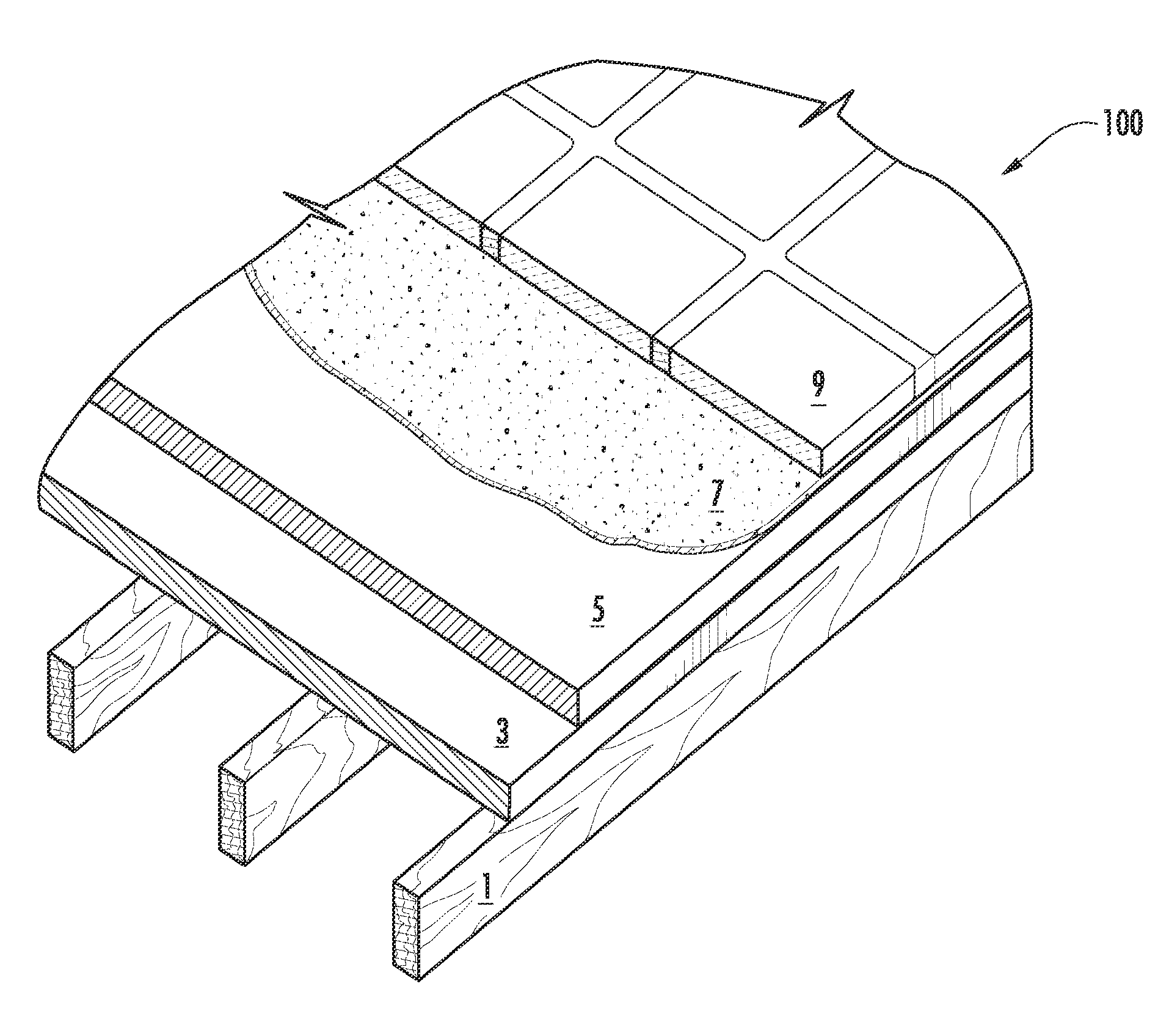Structural fiber cement building materials
a technology of structural fiber cement and building materials, applied in the direction of foundation engineering, synthetic resin layered products, solid waste management, etc., can solve the problems of increased labor costs, lack of dimensional stability, and high water damage to wood sub-floors,
- Summary
- Abstract
- Description
- Claims
- Application Information
AI Technical Summary
Benefits of technology
Problems solved by technology
Method used
Image
Examples
examples
[0049]The following examples are presented to further illustrate embodiments of the present invention and are not to be construed as unduly limiting the scope.
[0050]Structural floors are required to meet certain standards. In the US, fiber cement structural floors must be in compliance with the Acceptance Criteria For Fiber Cement Sheet Structural Floor Sheathing AC367 as set by the International Code Council Evaluation Services (ICC-ES). The acceptance criteria sets the minimum values for various properties, including structural loads, deflection under load, flexural strength, moisture movement, moisture content, water tightness, warm water resistance, shear bond strength, nail-head pull through, and fastener holding. As described further below, tests were conducted to ascertain the strength of exemplary fiber cement sheets, as compared to other formulations. The structural loads are concentrated static loads, impact loads, and uniform loads. The flooring must meet the minimum requ...
example i
[0051]TABLES 1 and 2 below illustrate example fiber reinforced cement formulations of the present invention (Table 1) and test results for these formulations (Table 2), more particularly, demonstrating the strength of the product as it relates to the product's ability to withstand concentrated or static loads. About 500 sheets of flooring were manufactured to the product requirement specification and tested for strength criteria.
TABLE 1FORMULATIONS FOR TABLE 2 RESULTSLow DensityAdditivePortlandSilicaCelluloseMicro-FormulaCementAggregateFiberAdditivespheresCalsil13639.7511.253100
[0052]TABLE 2 shows the requirements of concentrated static load based on the criteria for fiber reinforced cement single floor grade sheets. The fiber cement sheets with formulation 1 were tested in accordance with ASTM E661, and were tested dry, and wet / redry (exposed to three days of continuous wetting, followed by performing the test with re-dry samples). Two criteria were tested: (1) ability to withstand...
example ii
[0053]TABLE 3 below illustrates fiber reinforced cement formulations and test results for these formulations, more particularly, demonstrating the effects of increased amounts of low density additives
TABLE 3FORMULATIONS HAVING INCREASED AMOUNTS OFLOW DENSITY ADDITIVES AND EFFECTS ON CONCENTRATEDSTATIC LOAD TEST PERFORMANCEPortlandSilicaCelluloseLDAStaticForm.CementAggregateFiberAdditiveMicrospheresCalsilLoadDeflection13639.7511.2531008800.035443.228.811.021056850.19537.224.811.022505600.30
[0054]In TABLE 3, formulation 1 with 10% LDA exceeded the minimum requirements for strength and deflection to comply with AC 367. Formulations 4 and 5, with increased amounts of LDA, (15% and 25%, respectively) would lower the densities of the fiber cement sheet to improve nailability. However, the products having formulations 4 and 5 did not meet the minimum standards for deflections under load after concentrated static load testing, as the deflections for formulations 4 and 5 (0.19 and 0.30) were...
PUM
| Property | Measurement | Unit |
|---|---|---|
| Length | aaaaa | aaaaa |
| Length | aaaaa | aaaaa |
| Length | aaaaa | aaaaa |
Abstract
Description
Claims
Application Information
 Login to View More
Login to View More - R&D
- Intellectual Property
- Life Sciences
- Materials
- Tech Scout
- Unparalleled Data Quality
- Higher Quality Content
- 60% Fewer Hallucinations
Browse by: Latest US Patents, China's latest patents, Technical Efficacy Thesaurus, Application Domain, Technology Topic, Popular Technical Reports.
© 2025 PatSnap. All rights reserved.Legal|Privacy policy|Modern Slavery Act Transparency Statement|Sitemap|About US| Contact US: help@patsnap.com



